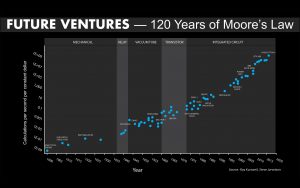Fast, Faster, Fastest

List of the world’s fastest 100 meter sprinters. Shorter time is better. Data retrieved from rankings.com
From horses to cars, trains to spaceships, many aspects of the world are happening in smaller time frames. For example, from Carl Lewis’ 1984 Olympic performance to Usain Bolt’s 9.58 s record at the Beijing Olympics. However, while sprinting has been slowly reaching its plateau, computational power has been exponentially growing.

Exponential growth of computational power over time
Modern day computers run at incredible speeds thanks to the even faster networks that have been developed today. From vacuum tube transistor to the 10 nm technology rolled out from Intel. Moore’s law is based on an observation by Gordon Moore, which found that the number of transistors that can fit inside an integrated circuit doubles every two years.
Since 2017, Moore’s law has shown signs of stagnancy. It should have been obvious that at some point, this prediction would no longer hold up simply due to the physical limitations of shrinking the transistor size. With contemporary technology, the resources of constructing a CPU (Central Processing Unit) with 14 nm transistors, which is equivalent to 70 Silicon atoms, is entirely feasible. When transistors begin to approach the size of electrons, not only is it harder to trap electrons which are what makeup electrical currents inside the computers and dictate the 0’s and 1’s bit of information stored on the computer, manufacturing these smaller transistors also poses a problem as well. CPUs which essentially the brain of the computers, are made up of dies cut from large silicon wafers which need to made from pure silicon (99.9999%). The problem is to make the patterns on the die, one needs to have a laser source that is already much smaller than the wavelength of purple light: 400 nm. Lasers with shorter and shorter wavelengths are being used and eventually similar to microscopes the wavelengths of light are not longer able to be manipulated smaller and other sources will have to be used.
While the future seems uncertain on the fate of future computers, it is also amazing to think that computers that were used to launch mankind onto the moon are now dwarfed by the power of electronic devices that fits into our pockets. For the vast majority of consumers, it is not how fast the computer runs that dictate our productivity but how we decide to utilise it.
References:
